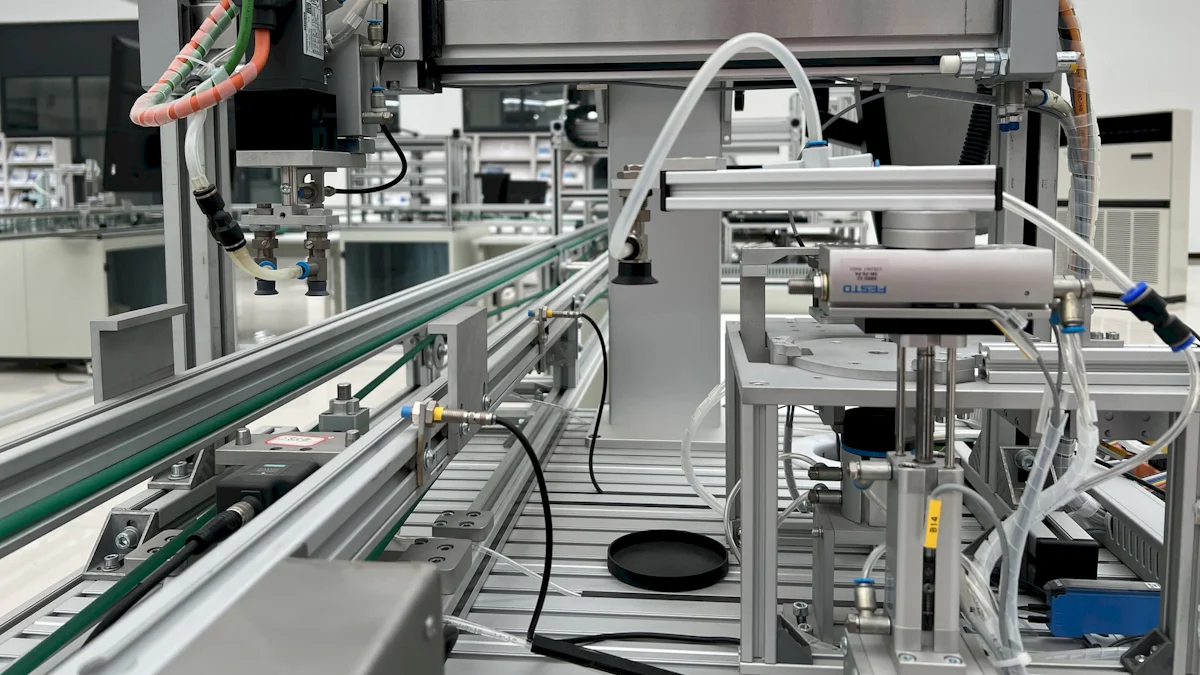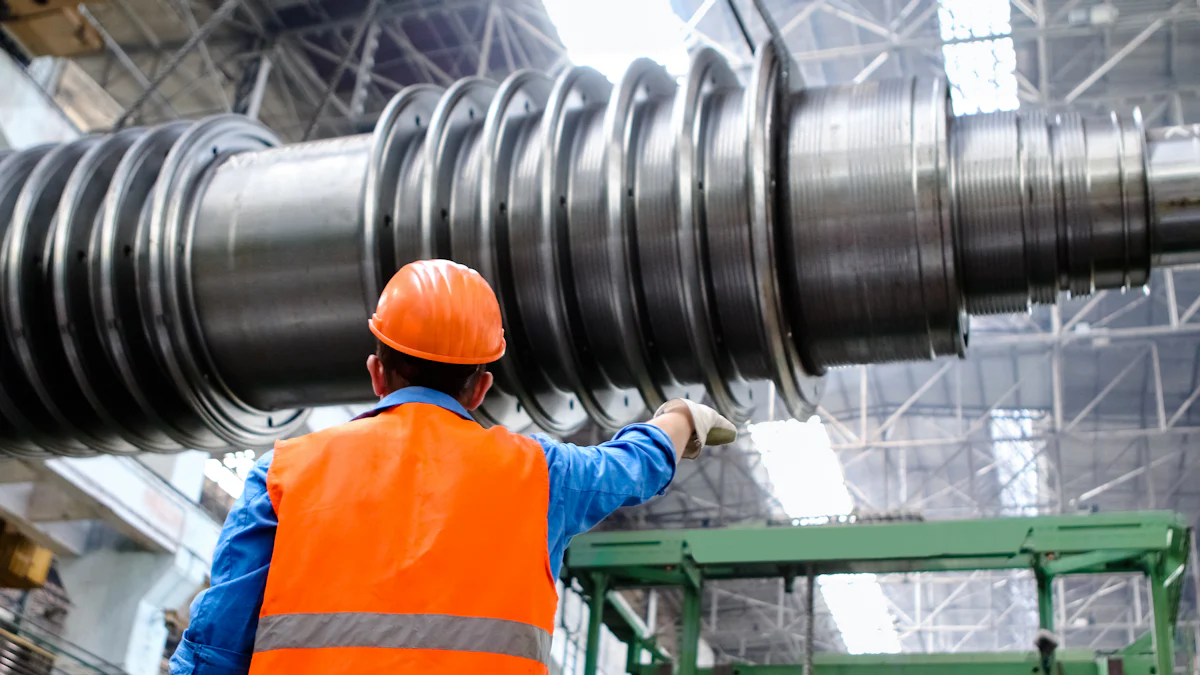Precision serves as the backbone of semiconductor production equipment component manufacturing. The intricate nature of semiconductor devices demands exact tolerances to ensure optimal functionality and reliability. Even the smallest deviation can compromise performance, leading to inefficiencies or defects. Advanced processes like photolithography and etching rely on precise alignment and uniformity to achieve consistent results. By maintaining microscopic accuracy, manufacturers enhance production efficiency, reduce waste, and uphold the stringent quality standards required in this industry. Precision not only guarantees superior device performance but also drives innovation and competitiveness in the rapidly evolving semiconductor sector.
Key Takeaways
Precision is crucial in semiconductor manufacturing, as even minor deviations can lead to defective components and compromised device performance.
- Maintaining microscopic tolerances enhances production efficiency, reduces waste, and ensures high-quality semiconductor components.
Advanced machining techniques such as CNC machining and precision grinding, are essential for achieving the exact dimensions required in semiconductor production. - Rigorous quality control and metrology practices are vital for verifying compliance with industry standards and minimizing defects.
- Investing in precision not only improves product reliability but also fosters innovation, allowing manufacturers to stay competitive in the rapidly evolving semiconductor market.
- High precision in manufacturing leads to enhanced customer trust and long-term partnerships, as clients value consistent quality and performance.
- By prioritizing precision, manufacturers can reduce production costs and improve yield rates, ultimately strengthening their market position.
Defining precision in semiconductor production equipment component manufacturing
Precision plays a pivotal role in semiconductor production equipment component manufacturing. It ensures that every component meets the exact specifications required for high-performance devices. The concept of precision extends beyond mere accuracy, encompassing the ability to consistently replicate results within microscopic tolerances. This consistency is vital for maintaining the integrity and functionality of semiconductor components.
Understanding precision in the context of semiconductor manufacturing
In semiconductor manufacturing, precision refers to the meticulous adherence to design specifications during the production of components. Manufacturers must achieve exact dimensions, alignments, and surface finishes to ensure compatibility with advanced technologies. Processes such as photolithography and etching demand unparalleled precision to create intricate patterns on wafers. Even a minor deviation can disrupt the entire production process, leading to defective components.
Precision also involves the use of advanced materials and tools. High-quality materials like silicon carbide and ceramics enhance the durability and stability of components. Tools such as wafer boats maintain precise positioning during critical processes, ensuring uniformity across production batches. By prioritizing precision, manufacturers uphold the reliability and efficiency of semiconductor devices.
The role of microscopic tolerances in achieving high-performance standards
Microscopic tolerances define the boundaries within which components must be manufactured to function optimally. These tolerances are measured in nanometers, reflecting the extreme precision required in semiconductor production equipment component manufacturing. Tight tolerances ensure that components fit seamlessly into complex systems, minimizing the risk of malfunctions.
Achieving microscopic tolerances requires advanced machining techniques and rigorous quality control measures. Precision machining removes material with exceptional accuracy, creating surfaces that meet exact specifications. Metrology tools verify these dimensions, ensuring compliance with industry standards. This level of precision directly impacts the performance and reliability of semiconductor devices, enabling them to meet the demands of modern technology.
"Precision is not just a requirement; it is the foundation of innovation in semiconductor manufacturing." This statement underscores the importance of maintaining microscopic tolerances to achieve high-performance standards.
Consequences of imprecision in semiconductor production equipment component manufacturing

Imprecision in semiconductor production equipment component manufacturing can lead to significant challenges. The intricate nature of semiconductor devices demands exact tolerances, and any deviation from these standards can disrupt the entire production process. This section explores the critical consequences of imprecision in semiconductor manufacturing, focusing on defective components and their impact on reliability, as well as reduced yield and increased production costs.
Defective components and their impact on reliability
Defective components undermine the reliability of semiconductor devices. Even minor inaccuracies in dimensions or alignments can result in components that fail to meet performance standards. For instance, a misaligned wafer during photolithography can distort the intricate patterns required for semiconductor functionality. Such defects compromise the integrity of the final product, leading to malfunctions or reduced lifespans.
The microscopic scale of semiconductor components amplifies the impact of defects. Unlike other industries, where minor imperfections may go unnoticed, semiconductor manufacturing operates within nanometer tolerances. A single defective component can disrupt the operation of an entire device, causing cascading failures in complex systems. This level of precision is essential to ensure the durability and stability of semiconductor equipment.
"Precision is the cornerstone of reliability in semiconductor manufacturing." This statement highlights the direct correlation between precision and the dependable performance of semiconductor devices.
Reduced yield and increased production costs
Imprecision directly affects production costs. When components fail to meet exact specifications, manufacturers must discard them, resulting in material waste and increased costs. The high cost of raw materials, such as silicon carbide and ceramics, further exacerbates the financial impact of low yields. Additionally, reworking defective components consumes valuable time and resources, delaying production schedules.
The demand for smaller, more powerful chips intensifies the need for precision. As semiconductor devices shrink in size, the margin for error becomes narrower. Imprecision at any stage of the manufacturing process can lead to widespread defects, reducing overall efficiency. This inefficiency not only increases production costs but also affects the competitiveness of manufacturers in the global market.
To mitigate these challenges, manufacturers invest in advanced technologies and quality control measures. Precision grinding and machining techniques ensure that components meet stringent tolerances, while metrology tools verify compliance with industry standards. These efforts minimize defects, enhance yields, and reduce costs, reinforcing the importance of precision in semiconductor production equipment component manufacturing.
Benefits of precision in semiconductor production equipment component manufacturing
Precision in semiconductor production equipment component manufacturing delivers significant advantages. It ensures the creation of high-quality components that meet the rigorous demands of modern technology. By adhering to exact tolerances, manufacturers achieve superior product performance and gain a competitive edge in the global market.
Enhanced product quality and device performance
Precision directly influences the quality of semiconductor components. Manufacturers produce parts with exact dimensions and flawless surface finishes, ensuring seamless integration into complex systems. This meticulous attention to detail enhances the functionality and durability of semiconductor devices.
High precision minimizes defects, reducing the likelihood of malfunctions. Components manufactured with microscopic tolerances exhibit consistent performance, even under demanding conditions. Processes like photolithography and etching rely on precise alignment to create intricate patterns, which are essential for advanced semiconductor devices. By maintaining these standards, manufacturers ensure that their products meet or exceed industry expectations.
Precision machining techniques refine these materials into components that deliver optimal performance.
Competitive advantage through innovation and customer trust
Precision fosters innovation in semiconductor production equipment component manufacturing. Manufacturers who prioritize precision develop advanced technologies that push the boundaries of what is possible. By achieving microscopic tolerances, they create components that enable the next generation of semiconductor devices. This innovation positions them as leaders in the industry.
Customer trust grows when manufacturers consistently deliver high-quality products. Precision ensures reliability, which builds confidence among clients. Businesses that invest in precision demonstrate their commitment to excellence, earning a reputation for dependability. This trust translates into long-term partnerships and increased market share.
Precision also reduces production costs by minimizing waste and improving efficiency. Manufacturers who achieve high yields can offer competitive pricing without compromising quality. This cost-effectiveness strengthens their position in the global market, allowing them to attract more customers and expand their reach.
"Precision is the bridge between innovation and trust in semiconductor manufacturing." This statement highlights how precision drives technological advancements while fostering strong customer relationships.
Technologies and processes enabling precision in semiconductor production equipment component manufacturing

Precision in semiconductor production equipment component manufacturing relies on advanced technologies and meticulous processes.
Advanced machining techniques for achieving exact tolerances
Advanced machining techniques form the foundation of precision manufacturing. These methods enable manufacturers to create components with exact dimensions and flawless surface finishes. Processes such as CNC (Computer Numerical Control) machining and precision grinding remove material with unparalleled accuracy. This ensures that every component adheres to the specified tolerances.
CNC machining uses computer-controlled tools to execute precise cuts and shapes. This technology minimizes human error and enhances repeatability, making it ideal for producing intricate semiconductor components. Precision grinding further refines surfaces, achieving smooth finishes that meet the stringent requirements of semiconductor production.
Electrochemical machining (ECM) also plays a critical role in achieving precision. This non-contact process removes material without generating heat, preserving the integrity of delicate components. Manufacturers use ECM to create complex geometries and intricate patterns that would be challenging with traditional methods.
These machining techniques not only enhance accuracy but also improve efficiency. By reducing material waste and production time, they contribute to cost-effective manufacturing. This combination of precision and efficiency underscores the importance of advanced machining in semiconductor production equipment component manufacturing.
The role of metrology and quality control in maintaining precision
Quality control encompasses the processes and tools used to maintain consistency and detect defects in manufacturing processes.
Coordinate Measuring Machines (CMMs) are essential tools in metrology. These devices measure the physical dimensions of components with nanometer-level accuracy. Manufacturers use CMMs to verify tolerances and ensure compliance with industry standards. Optical metrology, which employs lasers and cameras, provides non-contact measurement solutions for delicate components.
Quality control systems integrate metrology tools with automated inspection processes. These systems identify defects early, preventing defective components from advancing through production. Statistical Process Control (SPC) monitors manufacturing processes in real-time, enabling manufacturers to address deviations before they impact quality.
The combination of metrology and quality control ensures that every component meets the highest standards. These practices minimize defects, enhance reliability, and uphold the reputation of manufacturers in the competitive semiconductor industry.
"Precision is achieved through the synergy of advanced machining and rigorous quality control." This statement highlights the interconnected nature of technologies and processes in semiconductor production equipment component manufacturing.
Precision forms the cornerstone of semiconductor production equipment component manufacturing. It ensures components deliver consistent reliability, efficiency, and performance. Imprecision disrupts production, leading to defective products, higher costs, and diminished competitiveness. Conversely, precision fosters innovation, enabling manufacturers to meet the rigorous demands of the semiconductor industry. Advanced technologies, such as precision grinding and nanoscale fabrication, play a pivotal role in achieving microscopic tolerances. These innovations enhance accuracy and quality control. Maintaining the highest standards of precision remains essential for driving progress and supporting the future of cutting-edge technologies.
FAQ
What role does precision manufacturing play in the semiconductor industry?
Precision manufacturing ensures the creation of reliable and high-performance semiconductor components. It enhances production efficiency, improves yield rates, and guarantees the reliability of devices. By adhering to exact tolerances, manufacturers meet the stringent demands of modern semiconductor technologies.
How does precision in manufacturing processes affect plastic parts in semiconductor manufacturing?
Precision directly impacts the dimensional stability and quality of plastic parts used in semiconductor manufacturing. Even minor deviations can compromise functionality and reduce the lifespan of these components. Maintaining precision ensures that plastic parts perform consistently under demanding conditions.
Why is precision grinding crucial in semiconductor manufacturing equipment production?
Precision grinding plays a vital role in achieving the required tolerances for semiconductor manufacturing equipment. It ensures smooth surface finishes and exact dimensions, which are essential for the miniaturization and reliability of semiconductor devices. This process also enhances the durability of equipment, supporting long-term performance.
What is the importance of precision in manufacturing semiconductor devices?
Precision is fundamental in the production of semiconductor chips, transistors, and other components. Manufacturers rely on precise processes to create intricate patterns and structures at the microscopic level. This accuracy ensures that devices meet performance standards and function reliably in advanced applications.
What are some technological advancements in precision components for semiconductors?
Additionally, cutting-edge metrology tools ensure rigorous quality control, maintaining the highest standards of precision. The use of advanced materials, such as silicon carbide and ceramics, enhances thermal stability and electrical reliability.
How does precision manufacturing contribute to the miniaturization of semiconductor devices?
Precision manufacturing enables the creation of components with microscopic tolerances, which is essential for miniaturization. Processes like photolithography and etching rely on exact alignment to produce intricate patterns on wafers. This precision supports the development of smaller, more efficient semiconductor devices.
Why is quality control essential in maintaining precision during semiconductor manufacturing?
Quality control ensures that every component meets design specifications and industry standards. Tools like Coordinate Measuring Machines (CMMs) and optical metrology verify dimensions with nanometer-level accuracy. By identifying defects early, quality control minimizes waste and maintains the reliability of semiconductor devices.
How do advanced materials enhance precision in semiconductor manufacturing?
Advanced materials, such as silicon carbide and ceramics, offer superior properties like thermal stability and electrical reliability. These materials support the production of components with exact tolerances, ensuring consistent performance. Their durability also reduces the risk of premature failures in semiconductor devices.
What challenges arise from imprecision in semiconductor manufacturing?
Imprecision can lead to defective components, reduced yields, and increased production costs. Minor deviations disrupt the functionality of semiconductor devices, causing malfunctions or shortened lifespans. Addressing these challenges requires investment in advanced technologies and rigorous quality control measures.
How does precision manufacturing drive innovation in the semiconductor industry?
Precision manufacturing fosters innovation by enabling the development of advanced technologies. Manufacturers who achieve microscopic tolerances create components that support cutting-edge applications. This commitment to precision positions them as leaders in the industry, driving progress and meeting the demands of modern technology.



